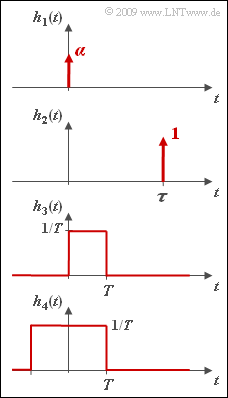The relation between the real part and the imaginary part of the transfer function of realizable causal systems is described by the Hilbert transformation. Here, the following holds:
- Im{H(f)}=−1π∫+∞−∞Re{H(ν)}f−νdν,
- Re{H(f)}=1π∫+∞−∞Im{H(ν)}f−νdν.
The following is used as a common abbreviation for these two integral transformations:
- Im{H(f)}∙−−−→Re{H(f)}.
Since the transformation and its inverse differ only by the sign, one equation is sufficient. Here, the following applies:
- To compute the operand marked by the arrow the positive sign is used.
- In contrast to this, the minus sign is taken into account for the computation of the operand marked by the circle.
The Hilbert transformation pertains much more generally than only to the case of application described here. For example, it is also used to determine the (complex) analytical signal corresponding to a real band-pass signal.
In this exercise, the corresponding frequency responses H(f) are to be determined for the causal impulse responses h(t) given in the diagram according to the inverse Fourier transformation.
If H(f) is decomposed into real and imaginary parts respectively, then Hilbert correspondences can be derived from it.
Please note:
- The exercise belongs to the chapter Conclusions from the Allocation Theorem.
- In particular, reference is made to the theory page Hilbert transform.
Questions
Solution
- The Fourier transform of h1(t)=α⋅δ(t) is:
- H1(f)=α⇒Re{H1(f)}=α,Im{H1(f)}=0.
(2) The last proposed solution is correct:
- The following frequency response is obtained for the impulse response h2(t) considering the shifting theorem and Euler's theorem :
- H2(f)=e−j2πfτ=cos(2πfτ)−j⋅sin(2πfτ).
- This results in the Hilbert correspondence
- cos(2πfτ)←−−−∙−sin(2πfτ)orcos(2πfτ)∙−−−−→sin(2πfτ).
(3) Both proposed solutions are correct:
- For the rectangular impulse response h3(t) of width T and height 1/T the spectral function is obtained according to the first Fourier integral:
- H3(f)=∫+∞−∞h3(t)⋅e−j2πftdt=1T⋅∫T0e−j2πftdt=[1−j⋅2πfT⋅e−j2πft]T0=1−e−j2πfTj⋅2πfT.
- Using Euler's theorem this can also be rewritten as follows:
- H3(f)=1−cos(2πfT)+j⋅sin(2πfT)j⋅2πfT=sin(2πfT)2πfT−j⋅1−cos(2πfT)2πfT.
- Furthermore, the following holds considering the transformation 1−cos(α)=2⋅sin2(α/2):
- Re{H3(f)}=si(2πfT)mitsi(x)=sin(x)/x,Im{H3(f)}=−sin2(πfT)πfT=−si(πfT)⋅sin(πfT).
(4) No is correct:
- The impulse response h4(t) is not causal so that no Hilbert correspondence can be derived from the associated Fourier spectrum H4(f) .
